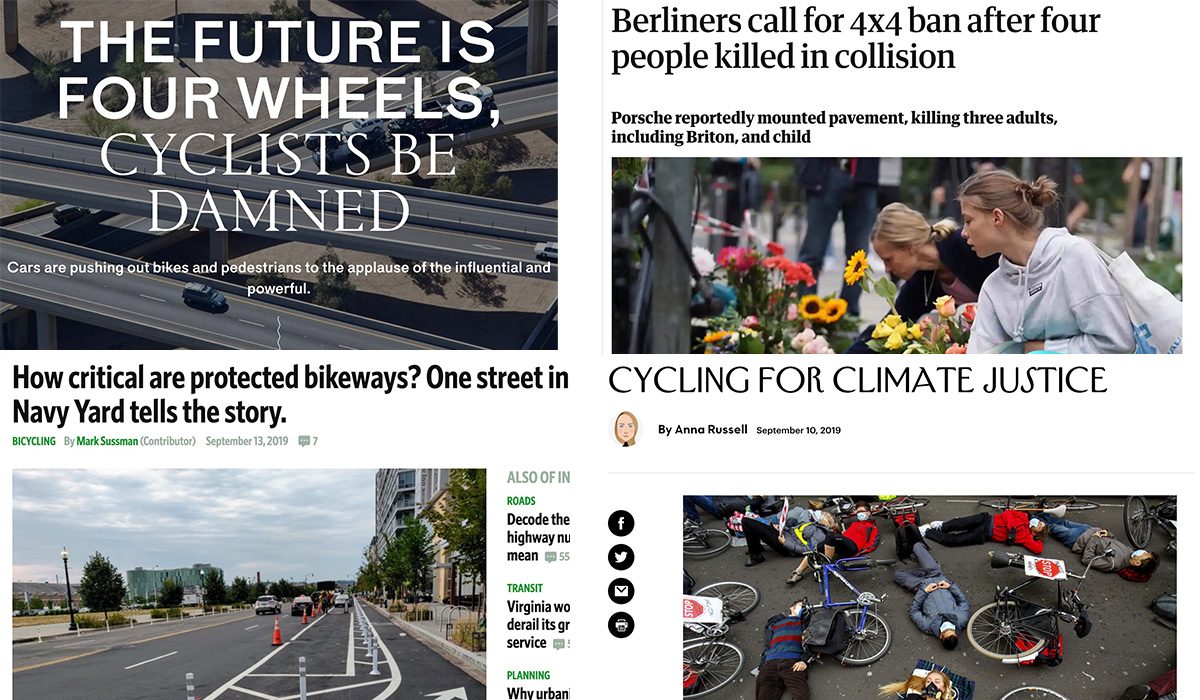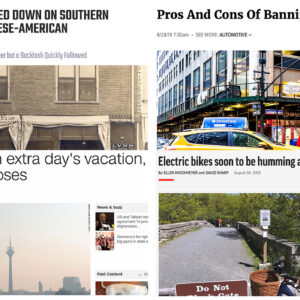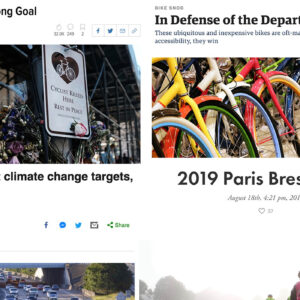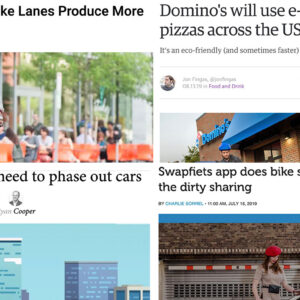Welcome to the week. Here are the most noteworthy items we came across in the past seven days…
But first, a word from our sponsor: Now through October 15th, get 15% off all new bikes and 20% off bags and rain gear at the Community Cycling Center’s end of summer sale!
Racing in Africa: Something special is happening in the formerly war-torn country of Rwanda: Organizers are cultivating a culture around professional cycling and they hope to host the World Championships in 2025.
Block party vibes: I was nearly moved to tears by this amazing coverage of 65 block parties in New York City.
Needs to be said: This piece in The Outline about about America’s dysfunctional transportation culture and how cars and their drivers have “destroyed civilization” is terribly on-point.
Big car ban: In Berlin, politicians want to ban big and fast SUVs following the death of four people who were killed after a man drove his Porsche Macan onto the sidewalk and ran over them.
Enforcement: Maybe I’m just too sensitive, but seems to me if you’re in charge of transportation safety in Portland it’s probably not a great idea to state publicly that there’s “no consequences” for breaking the law while driving.
The ‘War’ is on: Burgeoning safe street activism in New York City has the National Motorists Association sounding alarm bells.
Advertisement
Effect of protection: After a bikeway in Washington D.C. was updated and physically protected the number of reported blockages by auto users was dramatically reduced to zero.
Micromobility rankings: Honolulu’s preponderance of short trips helped it rank first in a new report from Inrix on micromobility potential. Portland came in 7th.
Seeing the light: Another American journalist has his mind blown after biking in The Netherlands and writes home about it.
Power of pedaling: A new study shows that indoor cycling can have about the same impact as drugs when it comes to decreasing symptoms of Parkinson’s disease.
AV advice: The National Association of City Transportation Officials (NACTO) has released their Blueprint for Autonomous Urbanism.
Screens kill: If federal regulators care about traffic safety they should preemptively ban this Byton M car and any other vehicle that has a distracting screen that spans the entire dashboard.
Bike activism in the U.K.: Interesting dispatch from the front lines of bike activism in the U.K. in this New Yorker column about a group called Stop Killing Cyclists.
EV taxes: I’m not a big EV fanboy or anything, but it still bothers me that so many states are charging more taxes to EV owners than folks who use gas-guzzlers.
— Jonathan Maus: (503) 706-8804, @jonathan_maus on Twitter and jonathan@bikeportland.org
Never miss a story. Sign-up for the daily BP Headlines email.
BikePortland needs your support.







Thanks for reading.
BikePortland has served this community with independent community journalism since 2005. We rely on subscriptions from readers like you to survive. Your financial support is vital in keeping this valuable resource alive and well.
Please subscribe today to strengthen and expand our work.
Chloe Eudaly and Joanne Hardesty are both right. Chloe is right to say that there is little to no traffic enforcement in Portland and Oregon, and Joanne is right to say that racial profiling pervades traffic stops.
I think that this is a really good reason to have speed and red light cameras. I know that cameras can’t test for DUII, but cameras also don’t discriminate between rich and poor, white and non-white.
Given that Oregon bans sobriety checkpoints, unless we can get that ban repealed by the legislature, I think we’re going to be stuck with drunks behind the wheel. Another reason not to venture out after dark.
You are right that cameras don’t discriminate, but when each case gets to court, white motorists are far more likely to get their fines reduced or eliminated, as they are usually represented in court by an attorney; black and Latinix motorists motorists are almost never represented and have been proven beyond any reasonable doubt to be convicted at a higher rate and fined a greater amount for the same traffic offenses. The systematic discrimination and bias is at the courts.
Do we have any statistics about equally represented people?
Well, they ARE a propaganda organization.
In Oregon cops are required to review traffic camera images and write citations.
This seems just as prone to bias as a traffic stop.
Instead of spending enormous sums of money on sporadic and ineffective enforcement, we should advocate for a far more effective and inexpensive solution:
https://www.theguardian.com/world/2019/mar/27/all-new-uk-cars-to-have-speed-limiters-by-2022-under-eu-plans
This would be ideal for sure, breathalyzers too. Could you imagine trying to pass something like that here? I think most regular drivers believe their right to their car and to drive however they want is enshrined in the constitution.
Have minority cops write those tickets. Problem solved.
I hope we can figure out how to fix these systems. It’s not like getting rid of courts and judges is really an option, and I think our current experience is showing the dangers of essentially eliminating traffic law enforcement.
Hardesty, maybe. Eudaly doesn’t play well with others.
Thanks for confirming that minority cops can still be biased against minorities.
Let me ask you this – do you have the expectation that all groups of people commit the same infractions at equal rates?
Definitely a reach to say that reviewing machine outputs is just as prone to bias. Since they aren’t actually interacting with the motorist, I would say the risk of bias would be quite a bit lower. There is still a chance, but it is much lower. Their job would just to confirm that the person driving matches the owner on the registration.
Our roads are getting deadlier. We need to take serious steps, and I think that bias concerns in automated enforcement are a relatively minor problem when we consider the big picture here. We need to save lives.
You are also right.
But the solution to systemic racism in this country simply cannot be to stop enforcing traffic laws.
That’s exactly what my post was about. Effective and unavoidable speeding enforcement.
Also, I’m not arguing that we should eliminate all active traffic enforcement but rather that we should not make this our primary push when it comes to reducing traffic violence.
I agree that enforcement is only a stopgap measure, but it is the one that can be spun up most quickly and used to staunch the damage until better, more lasting solutions can be put into place.
I love how the NMA article basically says boils the downsides of the so-called “war on cars” to two things: reduced-capacity streets allegedly make it more difficult for freight and emergency vehicles to get through.
Seems to me what makes it difficult for freight and emergency vehicles to get through is too many cars.
In terms of Chloe’s comments, we truly do need more enforcement. It’s sad that I can’t get a speed camera van to move from the bottom of SE 52nd (near Johnson Creek) to SE Flavel Dr without a bunch of hurdles and steps. What’s the point in the camera vans if they only show up at the same places at random times? I can almost list off 7-8 places they frequent. And while I think people somehow think they are indiscriminate, all photos still get reviewed by someone so it’s not 100% pure, but really, what’s the big deal in moving them around? – From someone who suffers from SE Foster being made “safer”
I agree that Honolulu has the greatest potential for micromobility trips in the U.S. Partly because of its climate, density and topography put also that it is such low hanging fruit with such an undeveloped non-car infrastructure that is just begging to be updated, without too much effort. Also, as a place that is on the very end of the oil supply chain it will feel the effects of the oncoming end to happy motoring first. I always think about what a true paradise Hawaii would be if they had the foresight to ban private automobiles many years ago like a giant version of Mackinac Island.
I’m all for more non-car travel options everywhere. But I feel like BikeNinja AND the authors of the cited article have never been to the part of Oahu where people actually LIVE. The topography is dramatically steep and the neighborhood roads are generally very narrow. The only way to put a non-car travel lane in the neighborhood I lived in was to bring the road down to a single lane road (for cars/buses) and then one lane for peds/bikes/scooters (if you wanted them). Not to mention the volcanic steepness of the hill itself (it was ~0.5 miles to my kid’s elementary school and the walk was HARD — I couldn’t ride my bike up the hill and I don’t know if you could do it with an electric scooter). And this neighborhood was not anomalous.
You don’t need to able to put non-car lanes in the neighborhoods to make Honolulu more amenable to walking/biking/etc. The metro core of Honolulu, Ala Moana, & Waikiki are flat and should be very suited to active transportation, but made intimidating by the presence of massive couplets like King & Beretania, or Ala Moana BLVD, or Kalakauau cutting right through the middle the most pedestrian-dense part of Hawaii.
There is a speed camera on Beaverton Hillsdale Highway (SW Portland) that I regularilly drive. I am IMPRESSED on how well the drivers have been educated in driving the speed limit. Previously, this area had 50-60 mph speeds, now it is 40mph OR BELOW! It is well posted, and it has a radar speed indicator for the traffic to see how fast they are going. In this particular case it has been working extremely well.
That camera made a huge difference. I lived in that area for 5 years or so, including during the time the camera was installed. Those things need to be deployed EVERYWHERE. Until enforcement of traffic laws begins, any project the city undertakes in the name of VZ is nothing more than an empty, spineless gesture.
Yes, motorists can be taught, although such education generally involves some tuition payments. More please.
quite apart from the political possibility, does anybody know what legal hurdles there are to implementing day fines in Portland or Oregon?
My guess would be that “equality under the law” would be a vulnerability, but at least one study concluded differently:
>>>
Both the Staten Island and the Milwaukee experiments occurred in lower courts. There is no inherent reason why day fines cannot be used more expansively in the higher courts. Indeed, it can be argued that the day fine will rationalize the administration of fines so that they can be used more frequently in the higher courts to deliver punishment.
<<<
https://www.ncjrs.gov/pdffiles1/Digitization/136611NCJRS.pdf
Bingo. If we had cameras at every intersection in the city, people just wouldn’t speed. If you know you are going to get a ticket every time, you change behaviors. The only folks getting nailed for tickets at that point would be the impaired, heavily distracted, or criminal (fleeing from a crime).
I want suburban motorists to be afraid of driving in Portland. They need to be afraid of traffic tickets for bad behavior. This is the only way we can save lives.
People who follow the rules have nothing to fear from being observed. A well-monitored society is an orderly society.
Driving is not protected in the Constitution. I have no qualms about the government punishing people for selfish behavior that puts innocent people at risk.
I think you’re making a slippery slope argument, but I really don’t think it applies to operating motor vehicles. Relatedly, I think it’s perfectly appropriate for commercial drivers to be monitored by GPS and disciplined or fired for traffic offenses like speeding.
Not a slippery slope at all. I agree about commercial drivers, but having what amounts to building a government surveillance system should concern everyone (do you really want ICE to have access to everyone’s movements and photos of drivers?)
I think there are ways to build in legal safeguards (prohibiting the collection of data not needed to prosecute infractions might be enough), so I don’t think it’s a show-stopper, but it is something that needs consideration and forethought.
Oh, yeah, I agree with you there. Always-on license plate cameras seem like an overreach, for instance. (Though I think they may have them in police cars now?) But cameras that only record when speeding or red-light running is detected seem much less overbearing.
I agree, and codifying it in law would help reassure people like me.
I can’t wait until the National Motorists Association starts a future article with the following paragraph:
In our experience, we have never seen the likes of what is going on in New York City with the war on houses. Not only has the city become one giant burglary trap with over 3.5 million housing units that we are not allowed to burglarize, soon the city/state plans to implement charging for real estate in the entire city.
That was supposed to be by BikeRound by the way.
It would have been irresponsible for her *not* to point out that people are constantly violating traffic laws with impunity. The first step to getting help is admitting you have a problem.
I saw the block party article too, and also thought it was great. I really enjoyed that each neighborhood had its own character, and thought the article was a great way to celebrate that diversity. Street parties are a great way to get to know your neighbors.
RE Vehicle fees:
>>> Illinois proposed a $1,000 fee on EV owners earlier this year. After an outcry, it was reduced to $250. (Still, that’s $100 more than an owner of a gas-powered car would pay, on average.) <<< [numbers were not provided for other states]
So the EV user would pay $100 more than the gas car driver to register their vehicle. Illinois gas tax is currently $0.38 per gallon, and the federal tax is $0.184 per gallon (so low!) for a combined total of $0.56 per gallon. Therefore, to substantiate charges of unfair treatment, the gas vehicle has to use less than 178 gallons of gas per year, which translates into being driven 5,357 if that vehicle gets 30 mpg. Given that most cars are driven more than this, it seems the EV user is still paying less tax than the gas car driver.
A $1,000 fee (as originally proposed) might smack of unequal treatment, but not $250.
And in Illinois, 41% of the electricity comes from burning coal, so I'm not sure how much better, from an environmental standpoint, an electric car is than a gas one. From a hating cars POV, they seem about equal. Electric cars are heavier, so they do more damage and are more dangerous than gas powered cars.
If it were up to me, EVs would not pay any fees at all, but if if they're going to, the rate in Illinois seems about right.
Cars don’t really do damage, unless they have studded tires. The vast majority of roadway damage comes from heavy trucks.
I actually feel better hearing you say that. My car has tires like this one; my winter tires are a little more aggressive.
https://www.youtube.com/watch?time_continue=21&v=cC-9GaIeWtM
they aren’t heavy enough to do more damage to roads (relative to trucks), but they are heavy enough to increase (over similarly sized ICE vehicles) ground-level pollution from tire and road surface wear and particulate resuspension.
That “compared to similarly sized vehicles” argument doesn’t really hold water … yet. BEVs, so far, are considerably smaller and lighter on average than other passenger vehicles. Remember that median vehicle mass exceeded two tons a number of years ago. My Leaf weighs several hundred pounds less than that. Of course (and we all dread this) we may eventually find our streets crawling with 7000 pound electric Tahoes.
sure. but my guess is that somebody who’s in the market for a Leaf isn’t choosing between that and an Excursion. more likely, they’re choosing between that and another small-ish sedan.
Remember that although Illinois’ electricity is heavy on coal, EVs use far less energy overall than gas cars. Most get 100mpgE or better, so the amount of electricity they are using, and the amount of emissions produced by power plants to run them, is still a lot lower than that of most gasoline cars.
Also remember that EV users are paying taxes on their electricity bills. I’ll have to look at my bill again, but a substantial part of my expensive electricity here in MN (about 15c/kWh) is going to taxes.
“no consequences” for breaking the law while driving… seems like “Vision whatever”.
I thought it was kinda funny that ride-share “contractors” were mentioned (twice, I think) as one of the “problems” with NYC traffic. Does the National Motorists Association know that these drivers are, um, motorists? In cars? Where’s the advocacy, man?
…in the NMA Sounding Alarm Bells story, BTW.
From the EV fees article:
“‘People should be allowed to choose a vehicle that’s safe, reliable, and better for the environment without being punished,’ says Shannon Baker-Branstetter, manager of cars and energy policy at Consumer Reports.”
Huh. Punished, indeed—or killed, whichever.
re: Big car ban
Politicians in Berlin calling for a city-centre ban on “tank-like” 4x4s is a good example of populist impulses to just do something in response to a tragedy, although the policies have little or no relationship to circumstances of the tragedy.
In this case, the driver is suspected of having a medical emergency, perhaps an epileptic seizure, and the car driven is almost identical in size, weight and drive train to a current model Subaru Outback. I point this out not because I’m a fan of big fast SUVs, or apathetic to pedestrian deaths. I just want to see social prescriptions, like a ban on a class of vehicle, discussed in the context of the problem they are trying to solve.
The Porsche Macan may bear a superficial resemblance to an Outback, but is quite a lot faster and more powerful. That may or may not matter to people on the sidewalk, but to say it’s nearly identical in drivetrain to the Outback is a bit off.
In any event, while it is interesting that this incident actually prompted people to talk about banning SUVs (not even remotely comprehensible in America) I don’t think anything along these lines will happen, even in Germany. FWIW, many years ago as SUVs were just started to catch on, I argued that vehicles over 4000 pounds should require a CDL to register. Enforcing rigorous training for owners of these vehicles, whose greater mass (and at the time, sloppy handling) caused so much more potential for injury to others, sure seemed like a good thing to me. I talked about this with a lot of people. Almost no one told me they thought it was a good idea (although many went on to eventually buy SUVs, as have most Americans).
In any event, I agree with you that arbitrarily categorizing vehicles isn’t the solution. If anything, part of the mess we have today is because the Feds artificially distinguish “trucks” from “cars”, applying different safety and environmental standards to SUVs than they do to cars. The Detroit-based “auto”makers have largely dropped automobiles from their lineups in response to low consumer demand, but it hasn’t helped that the way federal regulations are written has tilted the playing field in favor of vehicles labeled as “trucks” and against those labeled as “cars.” Current CAFE requirements, which used to help a little in tilting the balance the other way (although still applying lower standards to trucks than to cars) now are “footprint”-based, which means that fleet economy is based on how efficient an automaker’s vehicles are for their size, but don’t reward an automaker whose sales mix leans towards smaller than larger vehicles.
2020 Porsche Macan
Length 185”
Width 76”
Height 64”
Weight 4,099 lbs
All wheel drive
Horsepower 248
Torque 273
2020 Subaru Outback Turbo
Length 191″
Width 73″
Height 66″
Weight 3,772 lbs
All wheel drive
Horsepower 260
Torque 277
Quibbles over specs aside, I think we agree that a vague call to action is very different from crafting a reasoned, practical, and effective policy.
OK, didn’t realize Subaru had brought back the turbo version. Yes, those who opt for that version will have something in the same league as the base Macan.
It seems like Portland was taken unawares by unpermitted on-call ride share vehicles and also by the disposable scooter rash. Why not get out ahead of autonomous vehicles by requiring them to be used in autonomous mode only in prepared guideways on designated streets? A paint stripe in a scannable color or pattern would both guide the vehicle and cue other road users that some vehicles are no-handsing it.
We don’t have to be AV early adopters. Let’s put some effort into frequent, fast and safe mass transit.
But how do you get there, as a resident, from where you live? I bike commuted somewhat regularly from near the UH to downtown (on King & Beretania & sometimes Ala Moana part of the way, no less) and often walked the last 0.5 miles home. I absolutely agree we could get a significant percentage of rental cars and tourist traffic out of vehicles with better options between downtown/Ala Moana/Waikiki (the walk & bus options on those parts of the island actually are quite good already). However, even riding from the back of Manoa to the UH includes some significant elevation and narrow roads (with no street parking, so there’s not even that space available). Back to my original point — I don’t think the Oahu where most people LIVE is as flat as people would like it to be. And the great weather is actually pretty hot weather for commute cycling.